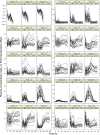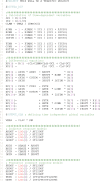Performance and robustness of the Monte Carlo importance sampling algorithm using parallelized S-ADAPT for basic and complex mechanistic models
- PMID: 21374103
- PMCID: PMC3085700
- DOI: 10.1208/s12248-011-9258-9
Performance and robustness of the Monte Carlo importance sampling algorithm using parallelized S-ADAPT for basic and complex mechanistic models
Abstract
The Monte Carlo Parametric Expectation Maximization (MC-PEM) algorithm can approximate the true log-likelihood as precisely as needed and is efficiently parallelizable. Our objectives were to evaluate an importance sampling version of the MC-PEM algorithm for mechanistic models and to qualify the default estimation settings in SADAPT-TRAN. We assessed bias, imprecision and robustness of this algorithm in S-ADAPT for mechanistic models with up to 45 simultaneously estimated structural parameters, 14 differential equations, and 10 dependent variables (one drug concentration and nine pharmacodynamic effects). Simpler models comprising 15 parameters were estimated using three of the ten dependent variables. We set initial estimates to 0.1 or 10 times the true value and evaluated 30 bootstrap replicates with frequent or sparse sampling. Datasets comprised three dose levels with 16 subjects each. For simultaneous estimation of the full model, the ratio of estimated to true values for structural model parameters (median [5-95% percentile] over 45 parameters) was 1.01 [0.94-1.13] for means and 0.99 [0.68-1.39] for between-subject variances for frequent sampling and 1.02 [0.81-1.47] for means and 1.02 [0.47-2.56] for variances for sparse sampling. Imprecision was ≤25% for 43 of 45 means for frequent sampling. Bias and imprecision was well comparable for the full and simpler models. Parallelized estimation was 23-fold (6.9-fold) faster using 48 threads (eight threads) relative to one thread. The MC-PEM algorithm was robust and provided unbiased and adequately precise means and variances during simultaneous estimation of complex, mechanistic models in a 45 dimensional parameter space with rich or sparse data using poor initial estimates.
Figures




Similar articles
-
Development of a new pre- and post-processing tool (SADAPT-TRAN) for nonlinear mixed-effects modeling in S-ADAPT.AAPS J. 2011 Jun;13(2):201-11. doi: 10.1208/s12248-011-9257-x. Epub 2011 Mar 3. AAPS J. 2011. PMID: 21369876 Free PMC article.
-
Parametric and nonparametric population methods: their comparative performance in analysing a clinical dataset and two Monte Carlo simulation studies.Clin Pharmacokinet. 2006;45(4):365-83. doi: 10.2165/00003088-200645040-00003. Clin Pharmacokinet. 2006. PMID: 16584284
-
Novel hybrid GPU-CPU implementation of parallelized Monte Carlo parametric expectation maximization estimation method for population pharmacokinetic data analysis.AAPS J. 2013 Oct;15(4):1212-21. doi: 10.1208/s12248-013-9524-0. Epub 2013 Sep 4. AAPS J. 2013. PMID: 24002801 Free PMC article.
-
Metropolis sampling in pedigree analysis.Stat Methods Med Res. 1993;2(3):263-82. doi: 10.1177/096228029300200305. Stat Methods Med Res. 1993. PMID: 8261261 Review.
-
A review of efficient Multilevel Monte Carlo algorithms for derivative pricing and risk management.MethodsX. 2023 Feb 11;10:102078. doi: 10.1016/j.mex.2023.102078. eCollection 2023. MethodsX. 2023. PMID: 36875343 Free PMC article. Review.
Cited by
-
Two mechanisms of killing of Pseudomonas aeruginosa by tobramycin assessed at multiple inocula via mechanism-based modeling.Antimicrob Agents Chemother. 2015 Apr;59(4):2315-27. doi: 10.1128/AAC.04099-14. Epub 2015 Feb 2. Antimicrob Agents Chemother. 2015. PMID: 25645838 Free PMC article.
-
Distinguishing Antimicrobial Models with Different Resistance Mechanisms via Population Pharmacodynamic Modeling.PLoS Comput Biol. 2016 Mar 11;12(3):e1004782. doi: 10.1371/journal.pcbi.1004782. eCollection 2016 Mar. PLoS Comput Biol. 2016. PMID: 26967893 Free PMC article.
-
Development of an Enantioselective and Biomarker-Informed Translational Population Pharmacokinetic/Pharmacodynamic Model for Etodolac.AAPS J. 2017 Nov;19(6):1814-1825. doi: 10.1208/s12248-017-0138-9. Epub 2017 Sep 5. AAPS J. 2017. PMID: 28875479
-
Combination Regimens of Favipiravir Plus Interferon Alpha Inhibit Chikungunya Virus Replication in Clinically Relevant Human Cell Lines.Microorganisms. 2021 Feb 2;9(2):307. doi: 10.3390/microorganisms9020307. Microorganisms. 2021. PMID: 33540830 Free PMC article.
-
Lithium in Paediatric Patients with Bipolar Disorder: Implications for Selection of Dosage Regimens via Population Pharmacokinetics/Pharmacodynamics.Clin Pharmacokinet. 2017 Jan;56(1):77-90. doi: 10.1007/s40262-016-0430-3. Clin Pharmacokinet. 2017. PMID: 27393139 Clinical Trial.
References
-
- Dempster AP, Laird N, Rubin DB. Maximum likelihood from incomplete data via the EM algorithm. J R Stat Soc B. 1977;39:1–38.
-
- Schumitzky A. EM algorithms and two-stage methods in pharmacokinetic population analysis. In: D’Argenio DZ, editor. Advanced methods of pharmacokinetic and pharmacodynamic systems analysis. New York: Plenum Press; 1995. pp. 145–60.
-
- Walker S. An EM algorithm for nonlinear random effects models. Biometrics. 1996;52:934–44. doi: 10.2307/2533054. - DOI
MeSH terms
Substances
LinkOut - more resources
Full Text Sources
Research Materials

